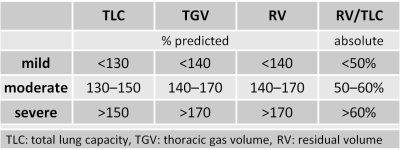Basics | body plethysmography | residual volume
Introduction
With spirometry, all air volumes we inhale and exhale can be recorded. However, this method does not allow the volume of air to be measured which always remains in the lungs after maximum exhalation (residual volume, RV). This can only be measured using body plethysmography. Other volumes such as total lung capacity (TLC), functional residual capacity (FRC) and thoracic gas volume (TGV) can only be determined by body plethysmography, as the residual volume is part of these volumes. An increased residual volume is typically present with emphysema (irreversible) and with air trapping (reversible under bronchodilation). Reduced residual volume is found with restrictive illnesses, in which case all air volumes are reduced.
Note: In this context, “capacity” is defined as a volume which is made up of more than one volume. For example, the vital capacity VC is comprised of tidal volume, inspiratory reserve volume and expiratory reserve volume.
 For those who want to learn more…
For those who want to learn more…
Indication
Diseases with possible emphysema or air trapping such as COPD, bronchial asthma, α1-antitrypsin deficiency.
Normal findings and normal values
The following system can be used to classify emphysema in everyday clinical practice:

Original findings

31-year-old female
Findings: normal.

67-year-old female patient
Findings: severe emphysema with only minimal decrease in residual volume under bronchodilation. Note: Act1 = actual value prior to bronchodilation, Act2 = actual value following bronchodilation.

 For those who want to learn more…
For those who want to learn more…